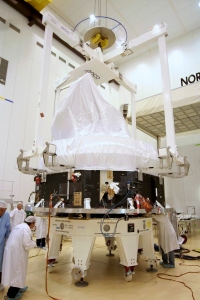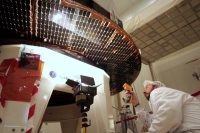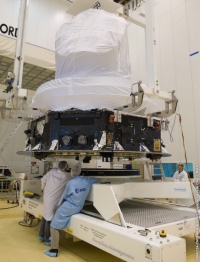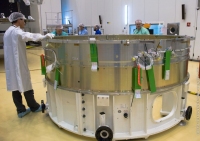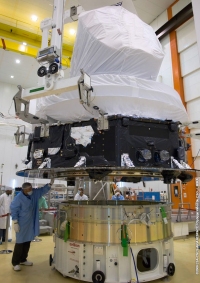Planck activities completed in S1B cleanroom - spacecraft ready to move to fuelling facility
14 April 2009
The past four weeks have been dedicated to the final Planck spacecraft preparations in the S1B cleanroom. The spacecraft is now ready to move to the S5A building for fuelling.In the past month the last of the system reference tests (SRT) have been completed and these have confirmed the good health of the spacecraft's telemetry and tele-command subsystem (TT&C). The other main activities that were performed during this period include the helium filling of the dilution cooler tanks, the spacecraft cleaning and finalisation, a solar array flood test and the mating of the spacecraft with the launcher adapter.
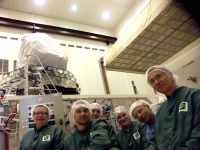 |
|
The helium filling team, 7 March 2009. Credit: ESA |
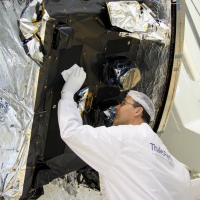 |
|
Cleaning a side panel on the service module. Credit: ESA |
Helium filling
Between 9 and 11 March the filling of the spacecraft's four helium tanks was performed. Using special pressurisation equipment the tanks were filled under very high pressure (up to 295 bar) with 3He (one tank) and 4He (three tanks).
The helium tanks are part of the spacecraft's cooling system that is designed to cool down the instrument focal plane units in several stages, reaching 0.1 K above absolute zero for the detectors of the HFI instrument. The coldest stage of the cooling system, responsible for reaching 0.1 K, is a dilution cooler that works by mixing the 3He and the 4He isotopes drawn from the helium tanks. During the course of the mission's operational phase the helium will slowly be depleted.
Spacecraft cleaning and finalisationSeveral cleaning and finalisation activities have been performed in March:
- The multi-layer insulation (MLI) at the top of the service module has been finalised
- The final inspection of the inside the spacecraft telescope baffle in horizontal position has been performed
- Cleaning of the V-grooves and other spacecraft surfaces has been completed
Solar array flood test
For a flood test of the solar array the Planck spacecraft was transferred from the multi-purpose trolley (MPT) onto the vertical integration stand (VIS). On 13 March the Planck vertical lifting device was lowered in place over the telescope and secured to the spacecraft in order to hoist it and transfer it to a vertical position.
The flood test of the solar array was performed on 16 March. Illuminating the various sections of the external part of the solar, the flood test verifies the proper electrical connection of the solar array to the spacecraft power system.
After the successful test the spacecraft was installed again on the MPT.
Mating with launcher adapter
On Wednesday 1 April Planck was mated with the launcher adapter ring (Adaptateur Charge Utile, or ACU). The ACU, an approximately 33 cm high lightweight metal cylinder used to fix the spacecraft to the launch vehicle, was secured to ground support equipment by means of an intermediate ring. Using the Planck vertical lifting device the spacecraft was hoisted up from the MPT and lowered onto the adapter. Fastening the ACU to the base of the Planck spacecraft is done by means of a clampband that surrounds the interface joint and holds the spacecraft and launcher adapter ring together. During the launch phase, two bolts holding the clampband will be cut with pyrotechnic devices after which four equally spaced separation springs installed on the ACU will push Planck away from the adapter.
The next major milestone in the Planck launch campaign will be the transport of the spacecraft to the S5A building for fuelling with hydrazine (N2H4). During the transport the spacecraft remains integrated with the ACU which in turn is bolted to a pallet. The pallet and spacecraft are transferred to the S5A building, some 5 km from the S1B building, within a payload transport container (Conteneur Charge Utile, or CCU).

